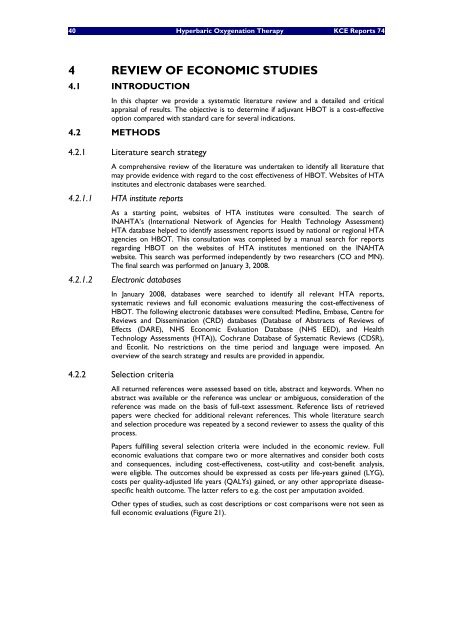Hyperbare Zuurstoftherapie: Rapid Assessment - KCE
Hyperbare Zuurstoftherapie: Rapid Assessment - KCE
Hyperbare Zuurstoftherapie: Rapid Assessment - KCE
Create successful ePaper yourself
Turn your PDF publications into a flip-book with our unique Google optimized e-Paper software.
40 Hyperbaric Oxygenation Therapy <strong>KCE</strong> Reports 74<br />
4 REVIEW OF ECONOMIC STUDIES<br />
4.1 INTRODUCTION<br />
In this chapter we provide a systematic literature review and a detailed and critical<br />
appraisal of results. The objective is to determine if adjuvant HBOT is a cost-effective<br />
option compared with standard care for several indications.<br />
4.2 METHODS<br />
4.2.1 Literature search strategy<br />
A comprehensive review of the literature was undertaken to identify all literature that<br />
may provide evidence with regard to the cost effectiveness of HBOT. Websites of HTA<br />
institutes and electronic databases were searched.<br />
4.2.1.1 HTA institute reports<br />
As a starting point, websites of HTA institutes were consulted. The search of<br />
INAHTA’s (International Network of Agencies for Health Technology <strong>Assessment</strong>)<br />
HTA database helped to identify assessment reports issued by national or regional HTA<br />
agencies on HBOT. This consultation was completed by a manual search for reports<br />
regarding HBOT on the websites of HTA institutes mentioned on the INAHTA<br />
website. This search was performed independently by two researchers (CO and MN).<br />
The final search was performed on January 3, 2008.<br />
4.2.1.2 Electronic databases<br />
In January 2008, databases were searched to identify all relevant HTA reports,<br />
systematic reviews and full economic evaluations measuring the cost-effectiveness of<br />
HBOT. The following electronic databases were consulted: Medline, Embase, Centre for<br />
Reviews and Dissemination (CRD) databases (Database of Abstracts of Reviews of<br />
Effects (DARE), NHS Economic Evaluation Database (NHS EED), and Health<br />
Technology <strong>Assessment</strong>s (HTA)), Cochrane Database of Systematic Reviews (CDSR),<br />
and Econlit. No restrictions on the time period and language were imposed. An<br />
overview of the search strategy and results are provided in appendix.<br />
4.2.2 Selection criteria<br />
All returned references were assessed based on title, abstract and keywords. When no<br />
abstract was available or the reference was unclear or ambiguous, consideration of the<br />
reference was made on the basis of full-text assessment. Reference lists of retrieved<br />
papers were checked for additional relevant references. This whole literature search<br />
and selection procedure was repeated by a second reviewer to assess the quality of this<br />
process.<br />
Papers fulfilling several selection criteria were included in the economic review. Full<br />
economic evaluations that compare two or more alternatives and consider both costs<br />
and consequences, including cost-effectiveness, cost-utility and cost-benefit analysis,<br />
were eligible. The outcomes should be expressed as costs per life-years gained (LYG),<br />
costs per quality-adjusted life years (QALYs) gained, or any other appropriate diseasespecific<br />
health outcome. The latter refers to e.g. the cost per amputation avoided.<br />
Other types of studies, such as cost descriptions or cost comparisons were not seen as<br />
full economic evaluations (Figure 21).

















